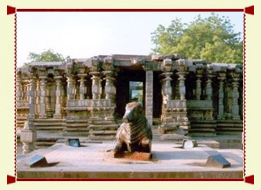 The Jain Dilwara temples of India are located about 2½ kilometers from Mount Abu, Rajasthan's only hill station. These temples dating back again from your 11th to the 13th century Advert are world popular for their beautiful utilization of marble. The 5 legendary marble temples of Dilwara would be the sacred pilgrimage in the Jains. They're an overwhelming blend of simple splendor and exquisite elegance. The marble temples have an opulent entranceway. The simplicity in architecture verily reminds one that Jainism as being a religion "encouraged honesty and frugality". The temples reside amidst mesmerizing environment of mango trees and wooded hills. A higher wall, shimmering luminous inside the sunlight, shrouds the temple complicated. The Jain Dilwara temples of India are located about 2½ kilometers from Mount Abu, Rajasthan's only hill station. These temples dating back again from your 11th to the 13th century Advert are world popular for their beautiful utilization of marble. The 5 legendary marble temples of Dilwara would be the sacred pilgrimage in the Jains. They're an overwhelming blend of simple splendor and exquisite elegance. The marble temples have an opulent entranceway. The simplicity in architecture verily reminds one that Jainism as being a religion "encouraged honesty and frugality". The temples reside amidst mesmerizing environment of mango trees and wooded hills. A higher wall, shimmering luminous inside the sunlight, shrouds the temple complicated.
Dilwara Temples, Mount Abu
Though the Jains developed some gorgeous temples at other locations in Rajasthan but none occur shut to those in terms of architectural perfection. The ornamental detail spread over the minutely carved ceilings, doorways, pillars and panels is simply marvellous and has to be noticed to become thought.
5 Exclusive Temples of Dilwara You'll find five temples in all, each with its personal exclusive identity though with each other they're named following the modest village through which they're situated. They are:
• Vimal Vasahi (Shri Adi Nathji temple)
• Luna Vasahi (Shri Nemi Nathji temple)
• Pithalhar (Shri Rishabh Deoji temple)
• Khartar Vasahi (Shri Parshav Nathji temple)
• Mahaveer Swami (Shri Mahaveer Swamiji temple)
One of the most popular of those are the Vimal Vasahi and Luna Vasahi temple.
Vimal Vasahi Temple
This temple carved completely out of white marble was constructed in 1021 Advert by Vimal Shah, a minister of Raja Bhimdeo. The temple is devoted towards the 1st Jain Tirthankara (instructor or guidebook) Adi Nath. The temple stands in an open up courtyard surrounded by a corridor, which has quite a few cells made up of smaller sized idols with the Tiranthakaras. The richly carved corridors, pillars, arches, and 'mandaps' or porticoes of the temple are basically remarkable. The ceilings function engraved styles of lotus-buds, petals, flowers and scenes from Jain and Hindu mythology.
The Rang mandap can be a grand hall supported by twelve decorated pillars and nicely carved out arches having a breathtaking central dome. Around the pillars are carved female figurines taking part in musical instruments and 16 Vidhyadevis or even the goddesses of knowledge each and every one keeping her personal symbol.
The Navchowki is actually a collection of nine rectangular ceilings, every one containing stunning carvings of various designs supported on ornate pillars. The Gudh mandap is really a easy hall when you action within its heavily decorated doorway. Installed right here could be the idol of Adi Nath or Lord Rishabdev, as he's also identified. The mandap is meant for 'Arti' to the deity. The Hastishala (Elephant Cell) was created by Prithvipal, a descendant of Vimal Shah in 1147-49 A.D and attributes a row of elephants in sculpture.
Luna Vasahi (Shri Nemi Nathji temple)
The Luna Vashi temple is devoted towards the 22nd Tirthankara Shri Nemi Nathji. This spectacular temple was built in 1230 Advert by two brothers - Vastupal and Tejpal - each ministers of a local ruler. The temple built in memory of their late brother Luna was created following the Vimal Vashi temple. The principal hall or Rang mandap functions a central dome from which hangs a massive ornamental pendent featuring elaborate carving. Arranged inside a circular band are 72 figures of Tirthankaras in sitting posture and just under this band are 360 little figures of Jain monks in another circular band. The Hathishala or elephant cell capabilities 10 beautiful marble elephants neatly polished and realistically modelled.
The Navchowki attributes many of the most wonderful and delicate marble stone reducing function of the temple. Each and every of the 9 ceilings here appears to exceed the others in elegance and grace. The Gudh mandap attributes a black marble idol with the 22nd Jain Tirthankara Neminath. The Kirthi Stambha is actually a large black stone pillar that stands around the left facet of the temple. The pillar was built by Maharana Kumbha of Mewar. The remaining three temples of Dilwara are smaller sized but just as elegant because the other two.
Pittalhar Temple
This temple was construct by Bhima Shah, a minister of Sultan Begada of Ahmedabd. A massive metal statue of Rishab Dev (Adinath), cast in 5 metals is set up in the temple. The primary metal employed on this statue is 'Pital' (brass), consequently the name 'Pittalhar'. The Shrine includes a primary Garbhagraha, Gudh mandap and Navchowki.
Parshavanath Temple
This temple, devoted to Lord Parshavnath was built by Mandlik and his loved ones in 1458-59 A.D. It consists of a 3 storied building, the tallest of all of the shrines at Dilwara. On all of the four faces from the sanctum on the ground flooring are four large mandaps. The outer partitions in the sanctum comprise of lovely sculptures in gray sandstone, depicting Dikpals, Vidhyadevis, Yakshinis, Shalabhanjikas along with other decorative sculptures similar to the ones in Khajuraho and Konark.
Mahaveer Swami Temple
This can be a little structure constructed in 1582 A.D. and dedicated towards the 24th Jain Tirthankara, Lord Mahaveer. You can find photos around the upper walls of the porch painted in 1764 A.D. by the artists of Sirohi.
|